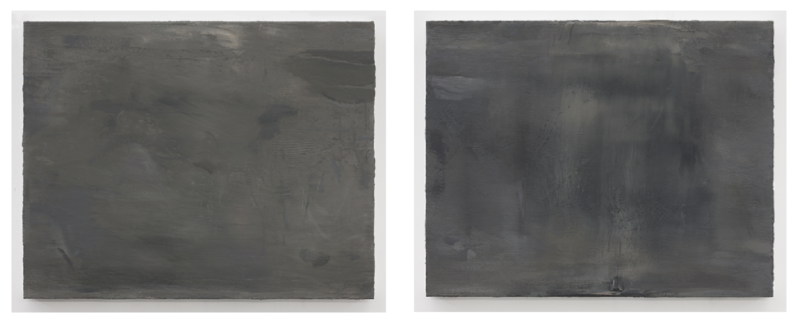David Schutter makes paintings from earlier paintings. He chooses an existing work, often obscure, with painterly techniques that interest him—for instance, a strange nocturnal still life by nineteenth-century painter Adolph Menzel, or a corporate portrait commissioned by the Dutch East India Company from the seventeenth-century artist Frans Hals. For months he sits in front of the work at a museum, making sketches and notes, then enters his studio and re-creates it entirely from memory. On its surface the resulting work looks nothing like the original: it’s usually a luminous, chromatic gray, sized to the scale of the source work. The paintings feel like apertures into alien yet somehow familiar terrain. His paintings’ motion, light, coloration, and myriad painterly effects uncannily all echo those of the originals, but they are extraordinary works in their own right. David and I spoke in his University of Chicago studio the night before he shipped these works—cryptically titled DP P 588 PR and DP P 587 PR—to Documenta 14.
—Jude Stewart
THE BELIEVER: Where did this diptych start?
DAVID SCHUTTER: I spent a year in Rome, and I wanted a project to sustain me on my exit. When I work, I find a source material and get obsessed with it. I exhaust my interaction with it by looking at everything from the picture itself to object files, [and by] talking with curators.

BLVR: What are object files?
DS: The keepers of any collection track how many times a work has been conserved, if it’s been realigned on a different support, when it’s been cleaned and by whom. If it’s had any X-ray, radiography, or spectral analyses. For an artist like Rembrandt, the object files can be dense. For lack of a better term, I tend to choose minor works that give off a sense of what painterliness is.
BLVR: What do you mean by “painterliness”?
DS: I don’t want to have a strict definition. What interests me is that we keep using that word over time to describe painting, and we have to use the actual name of the thing it’s describing. “This painting is painterly”; “This painting possesses painterliness.” It’s teleological; it’s not really describing anything.
BLVR: In that sense, all paintings are painterly—yet you wouldn’t describe them all that way. What were these works’ predecessors?
DS: [Documenta 14 contributing curator] Monika Szewczyk visited Rome, and we ended up talking about these paintings by Parentino, a little-known primitive Italian painter from the 1400s. He...
You have reached your article limit
Sign up for a digital subscription and continue reading all new issues, plus our entire archives, for just $1.50/month.
Already a subscriber? Sign in




